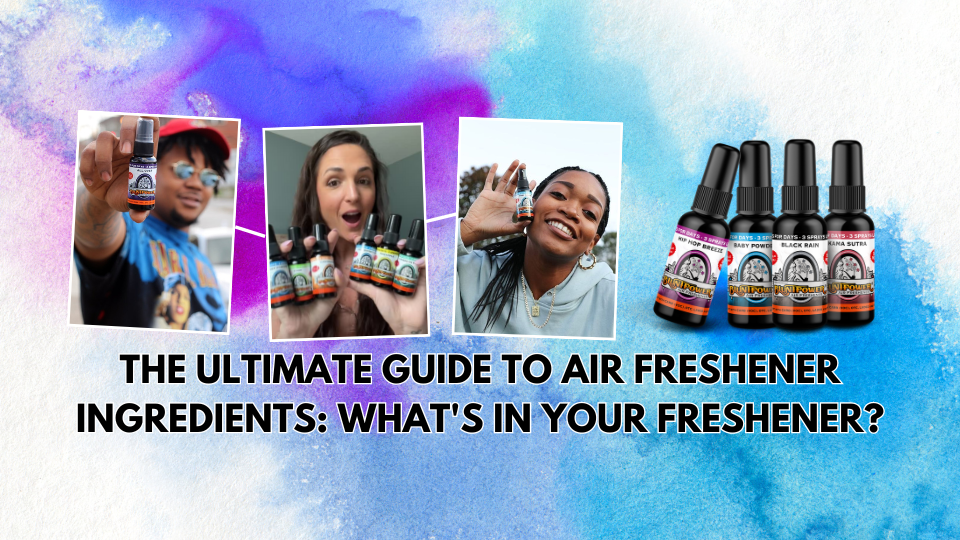
The Ultimate Guide to Air Freshener Ingredients: What's in Your Freshener?
|
|
Time to read 4 min
 My Account
My Account
|
|
Time to read 4 min
We all want a fresh-smelling home but rarely think about what’s inside those air fresheners. As consumers become more health and eco conscious, understanding what’s in our household products has never been more important.
This guide will break down air freshener ingredients so you can make informed decisions about the scents you bring into your home in 2024 and beyond.
Before we get into the nitty gritty, let’s start with why knowing what’s in air fresheners matters:
Health: Some ingredients can cause allergies or irritation in sensitive people.
Environment: Some components can affect indoor air quality and the planet.
Choices: Knowing what’s in them lets you choose products that match your values and needs.
Now, let’s get into what’s really in those bottles, sprays and plug-ins.
Air fresheners usually contain a combination of:
The main event, fragrance compounds are what give air fresheners their scent. These can be:
Natural Essential Oils: From plants, these provide real scents and potential aromatherapy benefits.
Synthetic Fragrances: Lab-created scents that last longer and are cheaper.
Solvents help dissolve and distribute the fragrance. Solvents include:
Water: The simplest and safest solvent.
Alcohol: Helps the scent evaporate faster.
Glycols: Enhance fragrance longevity but can contribute to indoor air pollution.
These create the spray effect in aerosol products:
Hydrocarbons: Propane, butane or isobutane.
Compressed Gases: Nitrogen or carbon dioxide.
These extend the product’s shelf life and prevent microbial growth. Examples:
Parabens
Benzyl alcohol
Sodium benzoate
These don’t just mask odors but eliminate them:
Chemical Neutralizers: React with odor molecules to cancel them out.
Absorbent Materials: Like activated charcoal which traps odor molecules.
Enzymatic Odor Neutralizers: Break down odor causing organic compounds.
These make sure all the ingredients mix together and stay stable:
Polysorbates
Sodium lauryl sulfate
Fragrance is usually the most complicated part of an air freshener’s formula. Here’s what you need to know:
Natural vs Synthetic: Natural fragrances come from plants, synthetic from labs. Both can cause irritation in sensitive people.
Common Essential Oils: Lavender, peppermint, citrus oils and eucalyptus are popular ones.
Controversial Ingredients: Phthalates, used to make fragrances last longer, have raised health concerns and are being phased out by many manufacturers.
Solvents are important but can be a concern:
Purpose: Dissolve fragrance oils and distribute the scent.
Safety Considerations: Some solvents, especially glycols, can contribute to indoor air pollution when they evaporate.
VOCs (Volatile Organic Compounds): Many solvents are VOCs which can have short and long term health effects when inhaled in high concentrations.
Reading product labels is key to knowing what’s in your air fresheners:
Ingredient Lists: Ingredients are usually listed in order of concentration, from highest to lowest.
"Fragrance" as a Catch-all: This can mean hundreds of undisclosed ingredients.
"Natural" and "Organic": These aren’t regulated for air fresheners so be careful.
Certification Logos: Look for trusted certifications like USDA Organic or EWG Verified for more transparency.
Air fresheners are generally safe when used as directed but there are some concerns:
Allergens and Irritants: Both natural and synthetic fragrances can cause allergic reactions or irritation in some people.
Long term Exposure: Some studies suggest links between long term exposure to certain air freshener ingredients and health issues.
Sensitive Groups: Children, the elderly and those with respiratory conditions like asthma may be more susceptible to air freshener ingredients.
Air fresheners affect more than our homes:
Indoor Air Quality: Some ingredients can contribute to indoor air pollution.
Biodegradability: Not all ingredients break down in the environment.
Packaging Waste: Think about the waste of disposable air freshener containers.
To minimize the risks:
Choose products with full ingredient disclosure.
Go fragrance free or naturally scented when possible.
Avoid aerosols to reduce your exposure to propellants.
Consider DIY alternatives with essential oils and natural ingredients.
The air freshener industry is changing in response to consumer pressure:
Natural Trend: More companies are offering plant based and essential oil options.
New Synthetics: New synthetic ingredients are being developed to be safer and more eco friendly.
Transparency: Expect to see more ingredient labeling in the future.
To help you understand air freshener ingredients here are some answers:
No. Both natural and synthetic ingredients can cause irritation or allergic reactions in some people. Natural doesn’t always mean safer – it depends on the ingredient and individual sensitivity.
Unfortunately, “fragrance” can be a proprietary blend that companies don’t have to disclose. Your best bet is to contact the manufacturer or choose products that voluntarily disclose all fragrance ingredients.
Air fresheners are regulated as consumer products by agencies like the Consumer Product Safety Commission in the US. But they don’t have to disclose all ingredients, especially in fragrances.
Yes, some air freshener ingredients can cause allergies or sensitivities in some people. Both natural (like essential oils) and synthetic fragrances can be allergens for some.
For aerosol cans, check local recycling guidelines: many can be recycled when empty. For other types, remove any remaining product (dispose of it in the trash, not down the drain) and recycle the container if possible. Always follow the disposal instructions on the product label.
Now you’re breathing easier with knowledge. Air freshener ingredients can seem complicated but being an informed consumer is your best defense.
Remember the freshest air comes not from a bottle or spray but from good ventilation and regular cleaning.
When you do use air fresheners choose ones with transparent labeling and ingredients you like.
As we go forward expect to see more innovations in air freshener ingredients with a focus on safer more natural options.
By being informed and making conscious choices you can have a fresh home without compromising on health or the environment.
